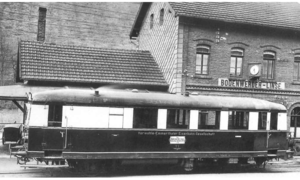VEE T 1
| VEE T 1 | |
|---|---|
|
T 1 in Bodernwerder lens
|
|
| Numbering: |
VEE : T 1 VDD : VT 1 SWEG : VT 1 |
| Number: | 1 |
| Manufacturer: | WUMAG Görlitz |
| Year of construction (s): | 1935 |
| Retirement: | 1977 |
| Type : | AA dm |
| Gauge : | 1435 mm ( standard gauge ) |
| Length over buffers: | 13,440 mm |
| Length: | 12,200 mm |
| Height: | 3,690 mm |
| Width: | 3,100 mm |
| Total wheelbase: | 7,000 mm |
| Empty mass: | originally 15,750 kg after conversion 19,400 kg |
| Service mass: | after conversion 24,500 kg |
| Top speed: | 65 km / h |
| Installed capacity: | originally 2 × 70 kW (2 × 95 PS) after conversion 2 × 107 kW (2 × 145 PS) |
| Wheel diameter: | 900 mm |
| Motor type: | Originally Daimler-Benz OM 67 after conversion KHD A8L64 |
| Motor type: | Six-cylinder four-stroke diesel engine |
| Rated speed: | 2,000 rpm |
| Power transmission: | Originally mechanical with Mylius gearbox after hydrodynamic conversion |
| Brake: | Compressed air brake type Knorr |
| Seats: | 62 |
| Classes : | 3. |
The VEE T 1 was a railcar of the Deutsche Eisenbahn-Betriebsgesellschaft (DEBG). It was used primarily as a tow car on various railway lines and was rebuilt several times. He has served 40 years and is no longer available today. The railcar was based on the DEBG designation scheme , which is why it always had the same designation on the routes it traveled on.
history
VEE T 1
After DEBG acquired the first diesel multiple units as early as 1933 , this multiple unit was bought by WUMAG Görlitz for operation as a towing unit for the Vorwohle-Emmerthaler Eisenbahn-Gesellschaft in order to rationalize operations on the line. Due to the gradient of the route, however, it could not transport more than one passenger car or one general cargo wagon. The railcar is said to have had unsuitable material for the axles when it was purchased, so that both axles had to be replaced after about four years.
VDD VT 1
After 1945 this railcar was confiscated by the military administration and did not return until 1948. The DEBG then used it on the Voldagsen – Delligsen railway line , where it was also used for towing services due to its double machine system. From 1953 he was on the Harmersbachtalbahn used.
In 1956 the railcar was rebuilt, whereupon the machine system was converted into two KHD A8L64 engines and with differential converter gearboxes as an automatic gearbox. The railcar received the ideal power of 2 × 145 hp for a tow railcar. In 1959 it was modernized in the Rastatt wagon factory , and the appearance of the railcar changed slightly as a result. From this conversion onwards, the railcar carried out all passenger and freight train services on the Harmersbachtalbahn. In the event of failure, he was represented by a steam locomotive.
SWEG VT 1
On May 1, 1963, the Harmersbachtalbahn, like the other DEBG routes in southern Germany, was taken over by Südwestdeutsche Eisenbahnen GmbH and the vehicle was sorted into their numbering plan. It was last used on the Kandertal Railway , in 1977 it was retired.
Constructive features
The railcar with the serial number 10.224 belonged to a series of vehicles for the small railways in Germany , for which Waggon- und Maschinenbau Görlitz (WUMAG) in Görlitz had created the construction drawings in 1933. The railcar, which was larger than the WUMAG type 2, was originally relatively powerfully motorized with 2 × 95 hp and each was equipped with a Mylius gearbox . However, the performance was not fully sufficient for the needs of the Vorwohle-Emmerthaler Eisenbahn-Gesellschaft , so the company acquired an even larger and more powerful car with the VEE VT 101 .
The underframe and the box frame, which was clad on the outside with 1.5 mm thick sheet metal, consisted of electrically welded structural steel profiles. This car was equipped with the pulling and buffing device at the factory due to the intended tasks. As a brake, the railcar had a one-way brake of the Knorr type , which was intended for a sidecar operation. The axles were only braked on one side. The interior was divided into the passenger compartment and the two driver's cabs. They were separated from one another by partitions and revolving doors.
For two-axle vehicles, the power of 2 × 95 hp was very high at that time. During the renovation, it was increased to 2 × 145 hp. The service weight increased by almost 4 t.
literature
- Meinhard Döpner: The Deutsche Eisenbahn Betriebs-Gesellschaft AG . In: Verlag Zeit und Eisenbahn . Lokrundschau Verlag GmbH, Gülzow 2002, ISBN 3-931647-13-7 .
Web links
- Data sheet for the vehicles on the Voldagsen – Delligsen railway with mention of VT 1
- Data sheet of the vehicles of the Vorwohle-Emmerthaler Eisenbahn-Gesellschaft with mention of the VT 1
- Photo of the VEE VT1 after reconstruction at the Joachim Schmidt Railway Foundation
Individual evidence
- ↑ Meinhard Doepner: The German railway operating company AG . In: Verlag Zeit und Eisenbahn . Lokrundschau Verlag GmbH, Gülzow 2002, ISBN 3-931647-13-7 , p. 150 .
- ↑ Meinhard Doepner: The German railway operating company AG . In: Verlag Zeit und Eisenbahn . Lokrundschau Verlag GmbH, Gülzow 2002, ISBN 3-931647-13-7 , p. 151 .
- ^ Gerd Wolff, Hans-Dieter Menges: German small and private railways. Volume 2: Bathing . EK-Verlag, Freiburg 1992, ISBN 3-88255-653-6 , p. 362 .
- ↑ VEE data sheet with mention of VT 1
- ↑ Wolfgang Theurich: From old archives , in: Eisenbahn-Magazin 4/95, page 22
